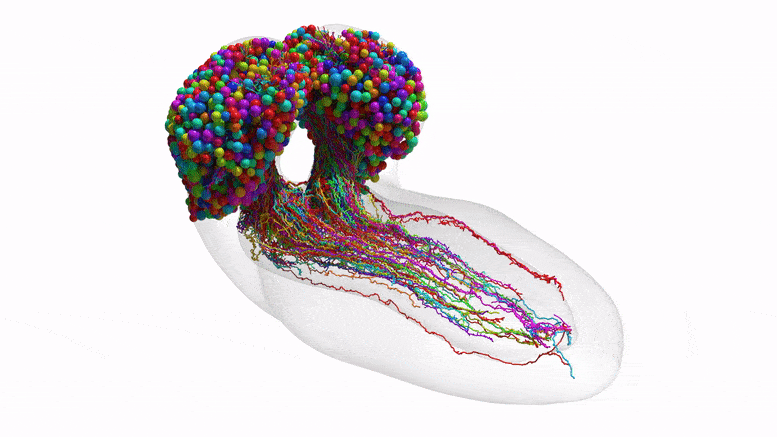Synapse-by-Synapse Mapping of Drosophila Brain
The complete set of neurons in an insect brain. Researchers have mapped the connectome of an entire Drosophila larva brain. This valuable resource reveals diverse neuron and connection types, extensive multisensory integration, and cross-hemisphere interaction, with structural features resembling prominent characteristics of machine learning networks. Credit: Johns Hopkins University/University of Cambridge
Researchers have created the first-ever connectome, or synaptic wiring diagram, of an entire Drosophila larva brain. This insect whole-brain connectome is more complex and larger than previously reported connectomes, consisting of 3016 neurons and 548,000 synapses. It provides a valuable resource for understanding brain function and neural circuits through detailed analysis of the diverse neuron and connection types, as well as structural features that resemble prominent characteristics of machine learning networks.
Researchers have presented the connectome – or synaptic wiring diagram – of an entire Drosophila larva brain.
This first-ever insect whole-brain connectome is larger and more complex than previously reported connectomes and represents a valuable resource for future experimental and theoretical studies of neural circuits and brain function. The brain comprises complex networks of interconnected neurons that communicate through synapses.

A diagram depicting the connectivity, where neurons are represented as points, and neurons with more similar connectivity are plotted closer together. Lines depict connections between neurons. The border of the figure shows example neuron morphologies. Credit: Johns Hopkins University/University of Cambridge
Understanding the brain’s network architecture is critical to understanding brain function. However, due to technological constraints, imaging entire brains with electron microscopy (EM) and reconstructing the full neural architecture of the brain has been challenging and only has been achieved in three organisms that have relatively simple brains containing only several hundred neurons.
Here, Michael Winding and colleagues present a synaptic-resolution, three-dimensional EM-based connectome of the larval Drosophila brain, which contains 3016 neurons and 548,000 synapses, and a far more complex organization than what is mapped by previous connectomes.
The connectome depicts how neurons communicate within each brain hemisphere and across brain hemispheres. Credit: Johns Hopkins University/University of Cambridge
Detailed analysis of the connectome allowed Wingding et al. to characterize diverse neuron and connection types and structural features, revealing extensive multisensory integration and cross-hemisphere interaction. The most recurrent neural architecture was associated with the input and output neurons of the brain’s learning center.

The complete set of neurons in an insect brain, which were reconstructed using synapse-resolution electron microscopy. Credit: Johns Hopkins University/University of Cambridge
According to the authors, some of the identified structural features, including multilayer shortcuts and nested recurrent loops, resembled prominent characteristics of state-of-the-art machine learning networks.
For more on this research:
Reference: “The connectome of an insect brain” by Michael Winding, Benjamin D. Pedigo, Christopher L. Barnes, Heather G. Patsolic, Youngser Park, Tom Kazimiers, Akira Fushiki, Ingrid V. Andrade, Avinash Khandelwal, Javier Valdes-Aleman, Feng Li, Nadine Randel, Elizabeth Barsotti, Ana Correia, Richard D. Fetter, Volker Hartenstein, Carey E. Priebe, Joshua T. Vogelstein, Albert Cardona and Marta Zlatic, 10 March 2023, Science.
DOI: 10.1126/science.add9330

The complete set of neurons in an insect brain. Researchers have mapped the connectome of an entire Drosophila larva brain. This valuable resource reveals diverse neuron and connection types, extensive multisensory integration, and cross-hemisphere interaction, with structural features resembling prominent characteristics of machine learning networks. Credit: Johns Hopkins University/University of Cambridge
Researchers have created the first-ever connectome, or synaptic wiring diagram, of an entire Drosophila larva brain. This insect whole-brain connectome is more complex and larger than previously reported connectomes, consisting of 3016 neurons and 548,000 synapses. It provides a valuable resource for understanding brain function and neural circuits through detailed analysis of the diverse neuron and connection types, as well as structural features that resemble prominent characteristics of machine learning networks.
Researchers have presented the connectome – or synaptic wiring diagram – of an entire Drosophila larva brain.
This first-ever insect whole-brain connectome is larger and more complex than previously reported connectomes and represents a valuable resource for future experimental and theoretical studies of neural circuits and brain function. The brain comprises complex networks of interconnected neurons that communicate through synapses.

A diagram depicting the connectivity, where neurons are represented as points, and neurons with more similar connectivity are plotted closer together. Lines depict connections between neurons. The border of the figure shows example neuron morphologies. Credit: Johns Hopkins University/University of Cambridge
Understanding the brain’s network architecture is critical to understanding brain function. However, due to technological constraints, imaging entire brains with electron microscopy (EM) and reconstructing the full neural architecture of the brain has been challenging and only has been achieved in three organisms that have relatively simple brains containing only several hundred neurons.
Here, Michael Winding and colleagues present a synaptic-resolution, three-dimensional EM-based connectome of the larval Drosophila brain, which contains 3016 neurons and 548,000 synapses, and a far more complex organization than what is mapped by previous connectomes.
The connectome depicts how neurons communicate within each brain hemisphere and across brain hemispheres. Credit: Johns Hopkins University/University of Cambridge
Detailed analysis of the connectome allowed Wingding et al. to characterize diverse neuron and connection types and structural features, revealing extensive multisensory integration and cross-hemisphere interaction. The most recurrent neural architecture was associated with the input and output neurons of the brain’s learning center.

The complete set of neurons in an insect brain, which were reconstructed using synapse-resolution electron microscopy. Credit: Johns Hopkins University/University of Cambridge
According to the authors, some of the identified structural features, including multilayer shortcuts and nested recurrent loops, resembled prominent characteristics of state-of-the-art machine learning networks.
For more on this research:
Reference: “The connectome of an insect brain” by Michael Winding, Benjamin D. Pedigo, Christopher L. Barnes, Heather G. Patsolic, Youngser Park, Tom Kazimiers, Akira Fushiki, Ingrid V. Andrade, Avinash Khandelwal, Javier Valdes-Aleman, Feng Li, Nadine Randel, Elizabeth Barsotti, Ana Correia, Richard D. Fetter, Volker Hartenstein, Carey E. Priebe, Joshua T. Vogelstein, Albert Cardona and Marta Zlatic, 10 March 2023, Science.
DOI: 10.1126/science.add9330
